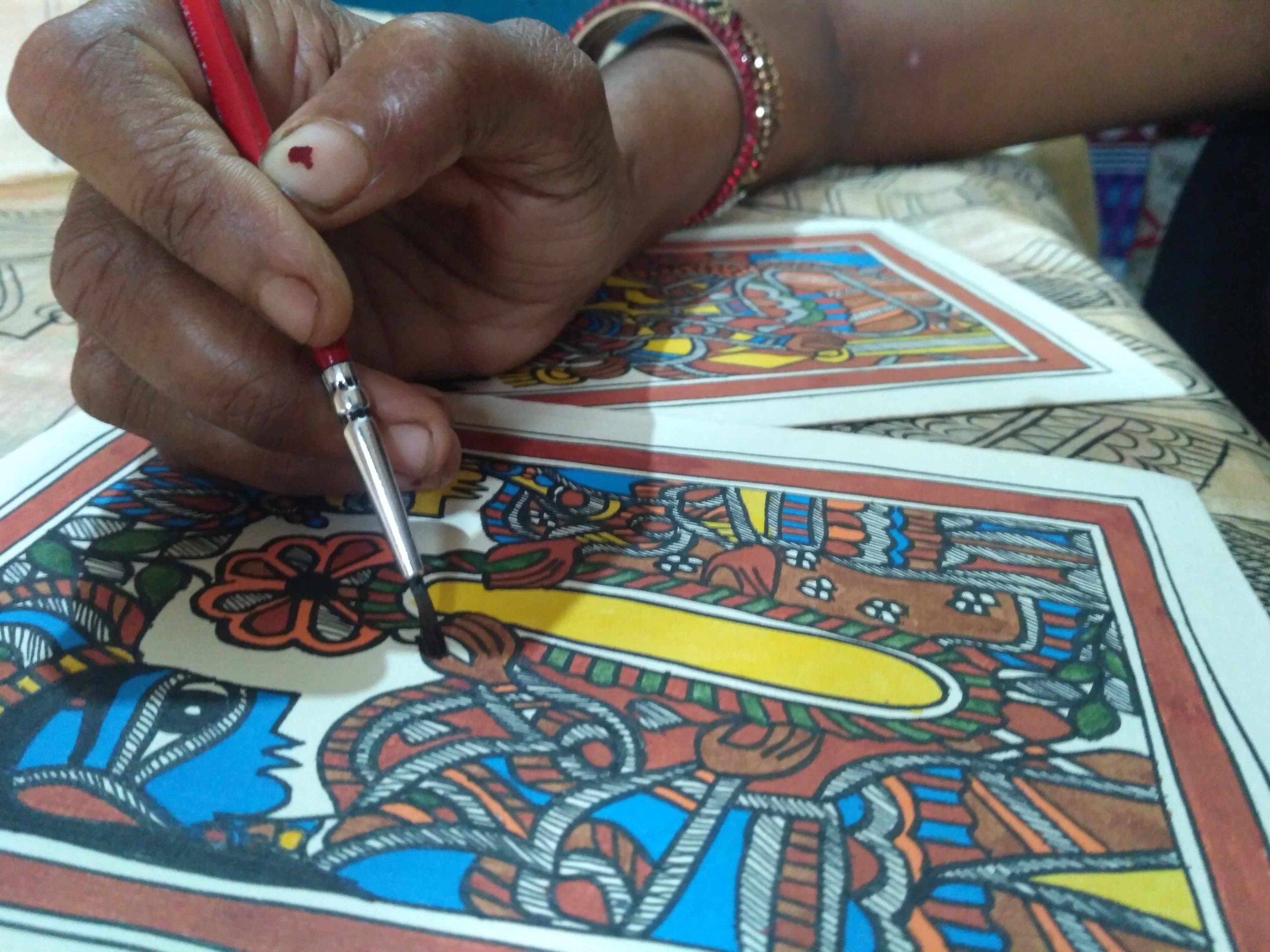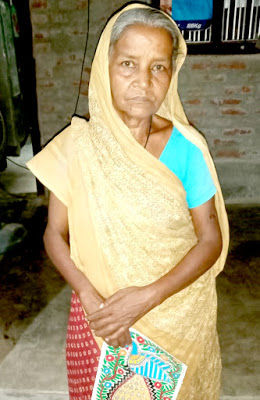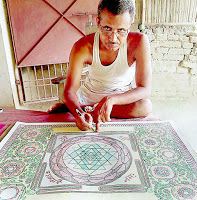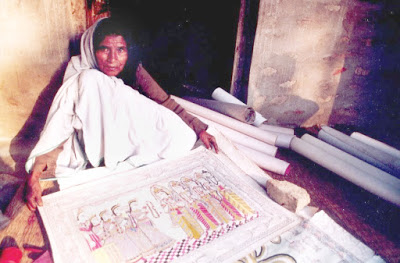The lockdown has exposed the hidden layers of the lives of Madhubani painting artists
Their earnings were never consistent. Once the lockdown ends, they won’t immediately start getting orders as people would prefer to save and not buy expensive Madhubani paintings

The lone surviving member in her family, 55-year-old Shakuntala Devi is one of the thousands of anonymous artists who make and sell Mithila paintings (or Madhubani paintings) for a living. Shakuntala, who lives in Jitwarpur in Bihar, has been a widow for a long time. With no children, she is now left alone in the house. She earns and supports herself by painting and selling it to her relatives or the local middlemen. However, through such sales, she only manages to get the bare minimum price for her paintings.
This was before the coronavirus pandemic and the subsequent lockdowns. Now, the situation has changed for worse.
“Because of the lockdown, people who have money are not willing to spend, and those who didn’t have money, their condition has worsened,” said Shakuntala. “Unable to go out, I am not able to sell any paintings. I am also not getting any new orders. Why would I block my capital unless there is some demand for the paintings? So, I simply busy myself with the household chores,” she added.

These artists usually sell their paintings at the Upendra Maharathi Shilp Anusandhan Sansthan in Patna. “I am not even sure if they would be buying anymore. At the moment, we only hope for the lockdown to end so that we can go to Patna and try our luck,” she said.
Her earnings have never been consistent. Before the lockdown, she would earn anywhere between Rs 500 and Rs 5,000 a month. There have been months she didn’t get a penny. But when the demand is high, she does not even get time to have her meals.
Shakuntala Devi was introduced to me by Sanjeev Kumar Jha, a 45-year-old artist also known as ‘Goluji’. He paints in the tantric style of Mithila painting and has inherited the knowledge of tantric style from his father, late Krishnananda Jha. Goluji has taken his father’s legacy a step further by incorporating contemporary influence with this style.
Talking about the impact of corona on his life and the contemporary scene, Goluji said: “I have not been particularly affected by such uncertainty. Anyway, I paint only when I feel inspired. Yes, because of the lockdown, my mind tells me to do some other work. I have sown a crop in my field after years. But as I was resuming farming after a long hiatus, I could not make the land more fertile. Nevertheless, whatever crop came up, it got ruined in the recent rains. I had looked forward to my mangoes, but they too have destroyed due to the hailstorms.”

Talking about the impact of the lockdown on the future of these artists, he said: “Even though the impact of a one-and-a-half month closure may not seem much, the artists in rural areas will feel the pinch after a while, because it is not that as soon as their the shop is opened, they would start earnings.”
He added: “There is a majority of artists who are able to spend money on paper and dye only after they receive some order. It will be another one-and-a-half-month after the order that they would earn after finishing and selling the painting. No one’s family would be able to run for three or four months like this, even more so for people already living a life full of deprivation.”
The Ranti village in Madhubani district is world famous for the ‘Kachni’ or line- based style of Mithila painting. It is also home to the family of late Yashoda Devi, the women artist honoured with two Padma Shris and numerous other national and state awards. The fame of Yashoda Devi today lays buried deep beneath the sands of time.

Hardly a handful of people remember this legendary artist. My family also remembers her only by two or three incidents – one that she had been painting at Amitabh Bachchan’s house when his son Abhishek Bachchan, in his childhood, had spoiled the painting by accidentally spilling some dye upon it. Because of her fear of flying, Yashoda ji never travelled by air even when she got some opportunity. Other things that remind us of her are that Yashoda ji once came to our house with a sock filled with food grains so that we would cook and let her eat. The memory of grain-filled sock still brings laughter. However, as soon as I recollect her misery and eyes worn with old age, I sigh.
Yashoda Devi used to live with her niece Kamala Devi in a rented one room shack. The reason was that she was a child widow who did not even remember her husband’s face properly, and her niece, Kamala’s husband had remarried after she had given birth to two daughters. This aunt-niece duo made its living through painting and settled in Ranti for good.

Her eldest daughter Jyoti Rani also does Madhubani paintings. Narrating an incident, she said: “A fund of about Rs six crore had come into the government office. We had been painting on the roadside under the sun, but then DM sir was transferred and our payment got stuck. When we went to ask for money from the office, they simply quoted ‘transferred’ and shooed us away. They said that the new DM sir has nothing to do with the old projects, yet if the money comes, we would get it.”
I came across numerous paintings done by Jyoti on roadside walls during my recent Madhubani trip. These paintings are already looking weather-worn even before the artist has received her remuneration. Perhaps, by the time the DM sir’s fund comes, there would be no evidence of their work left anymore on any wall.
She said: “Our ration card is not made. We are finding it difficult to get credit. I cannot even go to the city and give private tuitions. There are barely a few students in the village and even those find it difficult to pay a fee of Rs 500-1,000. Agreed that the people of the village are suffering but a civil court judge in Bihar had previously agreed to pay me Rs 5000 and had come to the village to take a painting with his security personnel from hundreds of kilometres away. The way, in which his people spoke to me, I gave away the painting at Rs 4,000. I did not want the villagers to see me with police and think something ill or declare me a corona patient.”
Jyoti makes her point and begins soothing her crying newborn child. I am not able to speak any further on the phone. The only thing I have understood is that while busying ourselves in inanely scrolling through the newsfeed on the screen of our mobile, we have given up going deeper.
Avinash Karna is a Madhubani painting artist. He has studied fine art from the Banaras Hindu University. The above views are his own.

